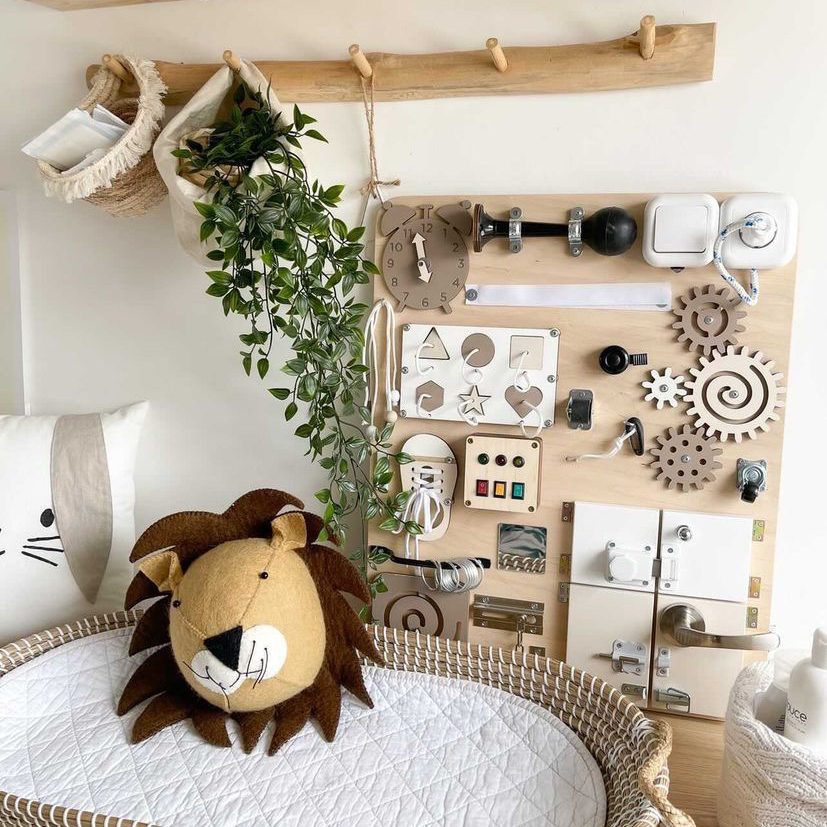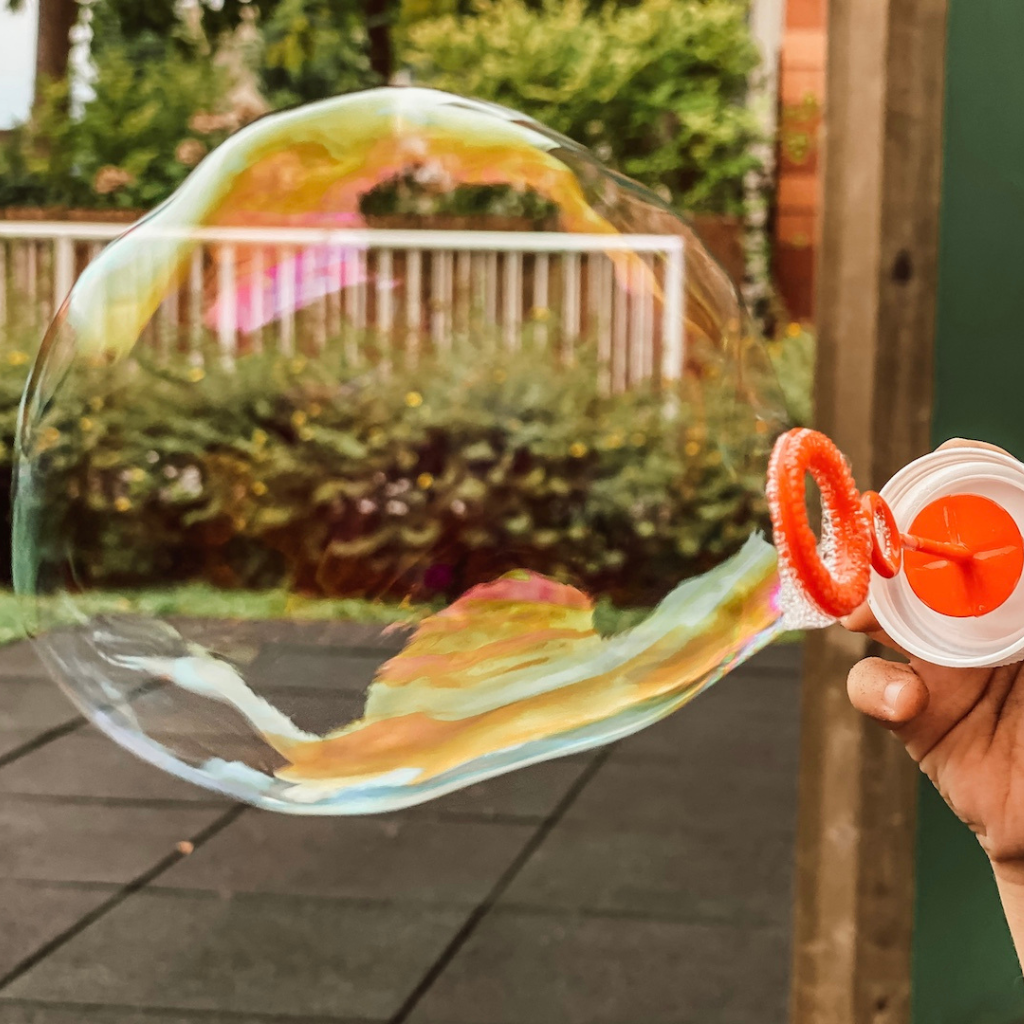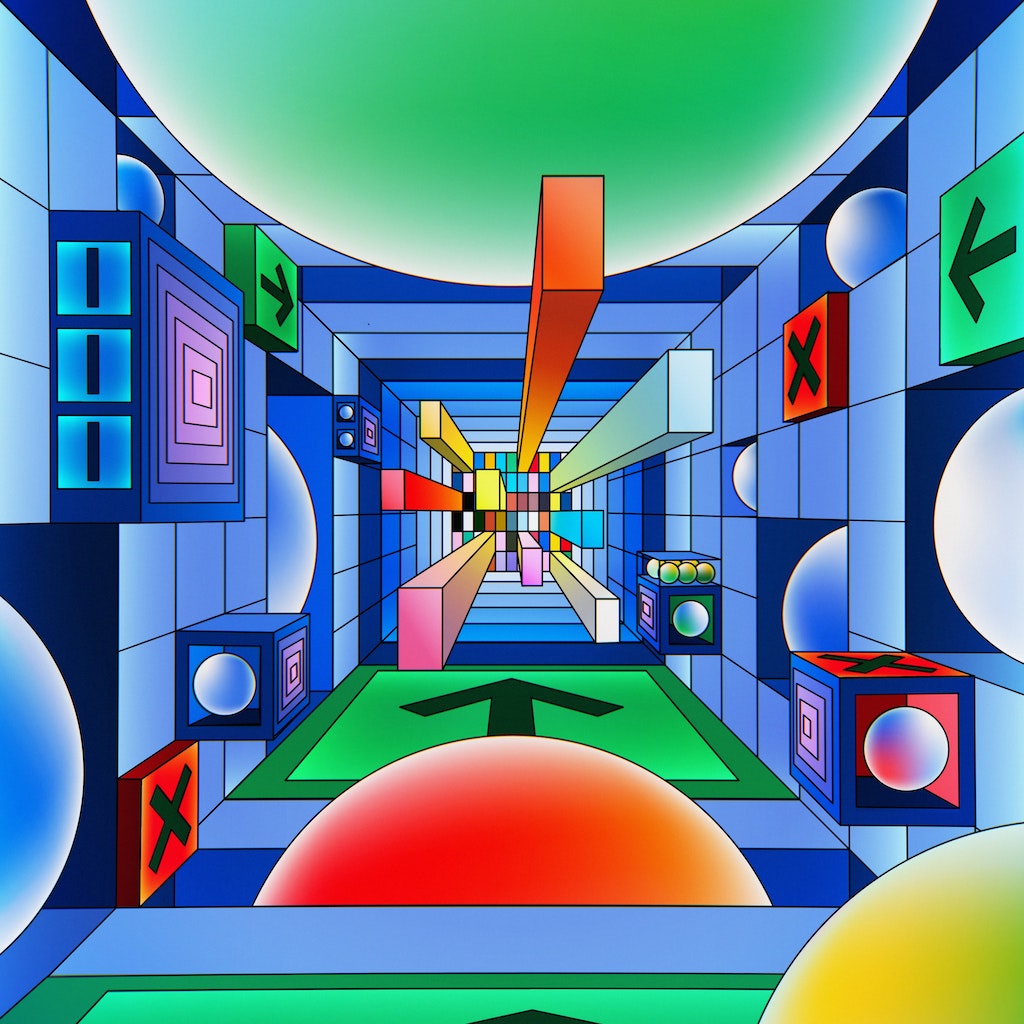Montessori Busy Boards and Engaged Happy Toddlers
Babies start to explore the surrounding world early in life. Tiny curious noses and fingers reach for everything that captures their attention. Babies want to touch and taste every single thing. A great tool to nourish this powerful curiosity is with a busy board. The Montessori busy board provides a modern and effective foundation to help boys and girls to develop many skills in a dynamic manner.
1. What is a Montessori busy board?
A busy board is a wooden architectural structure with various interactive objects and elements. It develops fine motor, thinking and concentration skills in toddlers. A busy board is synonymous with an activity board, a sensory board, a tactile board or a Montessori busy board. As a rule, one would place tactile elements, door handles, locks and latches, gears, laces, switches and many more onto boards. The main purpose of a good sensory board is to provide a child with interesting and safe objects for independent exploration.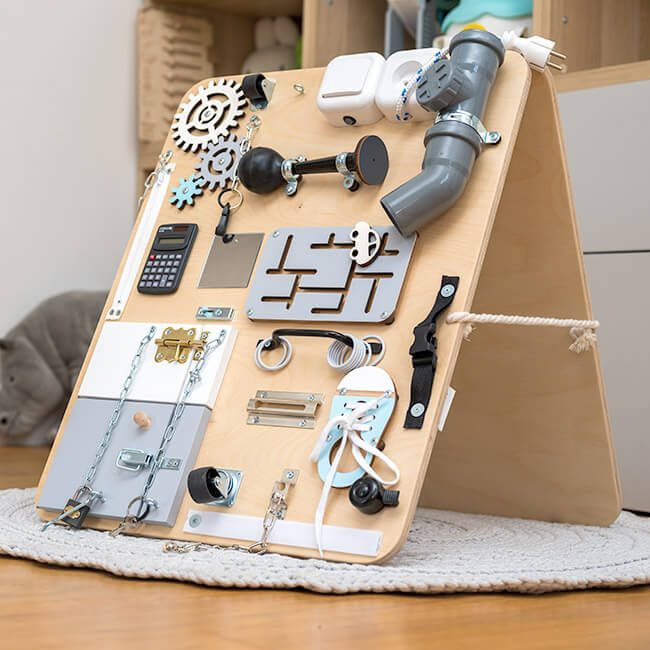
2. What is the origin and history of Montessori busy boards?
Today’s busy boards are a striking example of the Montessori teaching method. They were named after their inventor – Dr Maria Montessori (1870-1952). She would transfer all kinds of household appliances onto a board. She believed that by moving old-fashioned zips, door chains, beads, curtain rings, etc., it would benefit the child’s intellectual, verbal, sensory and physical development.
As a matter of fact, Maria Montessori was one of the first famous educators and physicians to point out the flaws of the former education system. It was too standardised and not adapted to the individual needs of children at all. For this reason, she proposed a more flexible approach with more optimal solutions. Namely, knowledge was not forced into the child’s mind but it would rather arrive there voluntarily – through natural curiosity. The most compelling evidence was Dr Montessori’s recognition for working with children with special needs.
For a century, Montessori education, together with activity boards, has been repeatedly criticised. Nevertheless, extensive creative and clever contributions from Montessori admirers (educators, researchers and parents) have resurrected the Montessori pedagogy. To this day it has been booming, particularly in the last 5-10 years. Interestingly, due to technological progress, the types of objects and toys used on Montessori boards have undergone many transformations over time. As a result, today’s sensory board looks much more engaging and much smarter to empower even more effectively “the absorbent mind”!
3. At what age to play with a busy board?
The answer to this question may vary considerably. Depending on how sophisticated busy boards can get!
Pedagogues and child psychologists believe that the simplest designs can already benefit from the age of 10 months. At this stage, the baby’s brain is developed enough. It can remember sensations of touch and draw some simple conclusions. Ultimately the best age for a sensory board is at 1 year.
Furthermore, the older the child, the more complex combos of busy board accessories are, according to specialists. Thus, it is essential to fill the wooden board with age- and interest-appropriate content. As an idea, parents even modify activity boards by replacing some existing objects with more sophisticated and interactive ones over time. As a result, it grows with children. It keeps stimulating the left and right hemispheres of the brain. It provides a safe space to explore and experiment. And it harmoniously leads to pretend and open-ended play, until about 4-5 years.
4. What can a busy board contain?
A funny story! The team of NeuroToys made an experiment 3 years ago – a DIY Montessori busy board. Would you only imagine the incurred costs, à la “Swiss Made”? We are located in Switzerland. We brought together 25 busy board objects of high quality, plus a wooden base. Some were bought locally and others from abroad. It cost us more than CHF 1’000! Isn’t it pricy? And how much time did we spend to equip it? It took us a full week – over a Christmas break! As you can see, in order to create such a sophisticated project, it would require a lot of resources: time, money, research and basic handyman skills.
We are definitely not discouraging you to try. But we are rather highlighting the amount of hard work behind busy boards. Yet, if you still want to go ahead – below you will find a list of busy board ideas for toddlers to consider.
4.1. Cool ideas for busy boards
| Buttons, switches, doorbells, lanterns; |
| Panels with sounds and LED lights; |
| Doors and locks to open/close, bolts, hooks, latches; |
| Labyrinths, carved paths, moving chips; |
| A dial, a clock, a disc phone; |
| A plug and a socket, wires, connectors, cords; |
| Sewing accessories (buttons, zippers, ropes, lacing, Velcro, rings, etc.); |
| Rotating gears demonstrate the action of coherent mechanisms; |
| Sorters for shapes, animals, numbers, etc.; |
| Furniture wheels, pegs, beads, push buttons; |
| Magnets, puzzles, markers and chalkboards; |
| Musical instruments (a xylophone, a drum, a tambourine, maracas, etc.). |
All the elements should be movable, fully functional and ideally have symbiotic relationships with nearby elements.
5. Safety and quality of busy boards
5.1. Ensure to question the safety of busy boards!
Once you own an activity board, you need to adhere to rules in order to protect little explorers from unintentional injury:
- Tactile boards should be tested and certified
- Under the age of 3 years, parents’ or guardians’ presence during play is a must
- If small busy board elements are detachable, remove them temporarily to avoid choking hazards
- Before and after use, securely fix and screw all loosened busy board materials to the board
5.2. Pay attention to the quality of busy boards!
The more monochrome the design of the busy board is, the higher the attention span a child achieves. All busy board accessories should be functional and even multi-functional. Let’s say, a light switch does not work. Then the usefulness of this object becomes highly questionable in the human mind. Consequently, the child’s interest in the busy board quickly faints. In terms of material quality, sensory boards should contain non-toxic paints. They should have well-polished woodworking surfaces and be equipped with durable fun fidget tools and educational toys.
6. Why do children neuropsychologists love and recommend a Montessori busy board?
Some say – too many accessories at once; some praise an activity board up to the skies! Based on the busy board reviews, the answer is logical. It all depends on a child’s pace and readiness. For example, Montessori parenting fans and specialists have been re-discussing this particular topic in Montessori Facebook groups: “Are busy boards worth it? Are there busy board benefits? Doesn’t the brain get over-stimulated to absorb so much information at once?”
Indeed, it is a strong valid point, especially if a child has atypical sensory behaviours, like Sensory Processing Disorder (SPD). Or some autistic children may only be able to understand the concept of a busy board by the age of 4 years. Or rather earlier, before turning 12 months. One never knows, how activity boards can totally play out unpredictable scenarios among children with ADHD tendencies or diagnosis. Yet, based on the empirical research of NeuroToys, the benefits still outweigh the drawbacks.
6.1. Colours & skills
For instance, colours play an important role. Uniformity of colours allows small kiddos to fully concentrate on the properties and functionality of each element. Children particularly at this age are only starting to learn how to focus and concentrate on tasks. And if a baby or toddler plays with a very colourful busy board, it may lead to a scattered attention span. Thus, strive for minimalistic and more pastel colours.
Thanks to engagement with the busy board, the child learns a great array of skills. Different functions, shapes, textures and colours of objects stimulate the child’s rapid development. Push, pull, slide, press, insert, remove, open, close, rotate, poke, pinch, twist, switch! So many manipulations on one sensory board your child can explore! Busy boards are a great alternative to help create new neurones and strengthen neural pathways in both hemispheres of the brain playfully.
7. So what skills do children learn during their play with Montessori busy boards?
7.1. Sensorial, curious and intuitive perception via busy boards
The activity board is a must-have for sensory development. It provides a lot of tactile and visual stimuli. It develops the inner world through the external environment. In the majority of cases, small children independently and intuitively discover functions of objects, minimising overparenting.
Another highlight among skills goes to sensory memory (E. Glass & S. Sachse, 2008). It consists of iconic (of image), auditory or echoic (of sound) and haptic memory (of touch). Let’s look at it in terms of busy boards. It creates a connection between the image of an object, the action to press the button and the sound associated with this duo. In other words, the purpose of sensory memory is to retain information long enough to be recognised. Then selected information will be passed onto the short-term memory region in the brain. While sensory memory may seem very brief, it plays a critical role in the attention and memory processes during the whole lifespan of a growing child.
Furthermore, instead of forbidding your child to touch sockets, locks or buttons in your household, use them in play. This is where the busy board satisfies children’s curiosity in a smart and safe way. Consequently, it reduces their interest in inaccessible in-house hazardous appliances! Needless to say, activity busy boards are also great for the parents’ or guardians’ nervous system!
7.2. Promoting strength of fingers, coordination, logic, focus and speech
Once children activate the muscles and bones of their little fingers through operational work, they improve manual dexterity and hand-eye coordination. They gradually prepare hands for pre-writing skills. Additionally, by constantly strengthening fine motor skills, it accelerates the development of speech, memory and logic.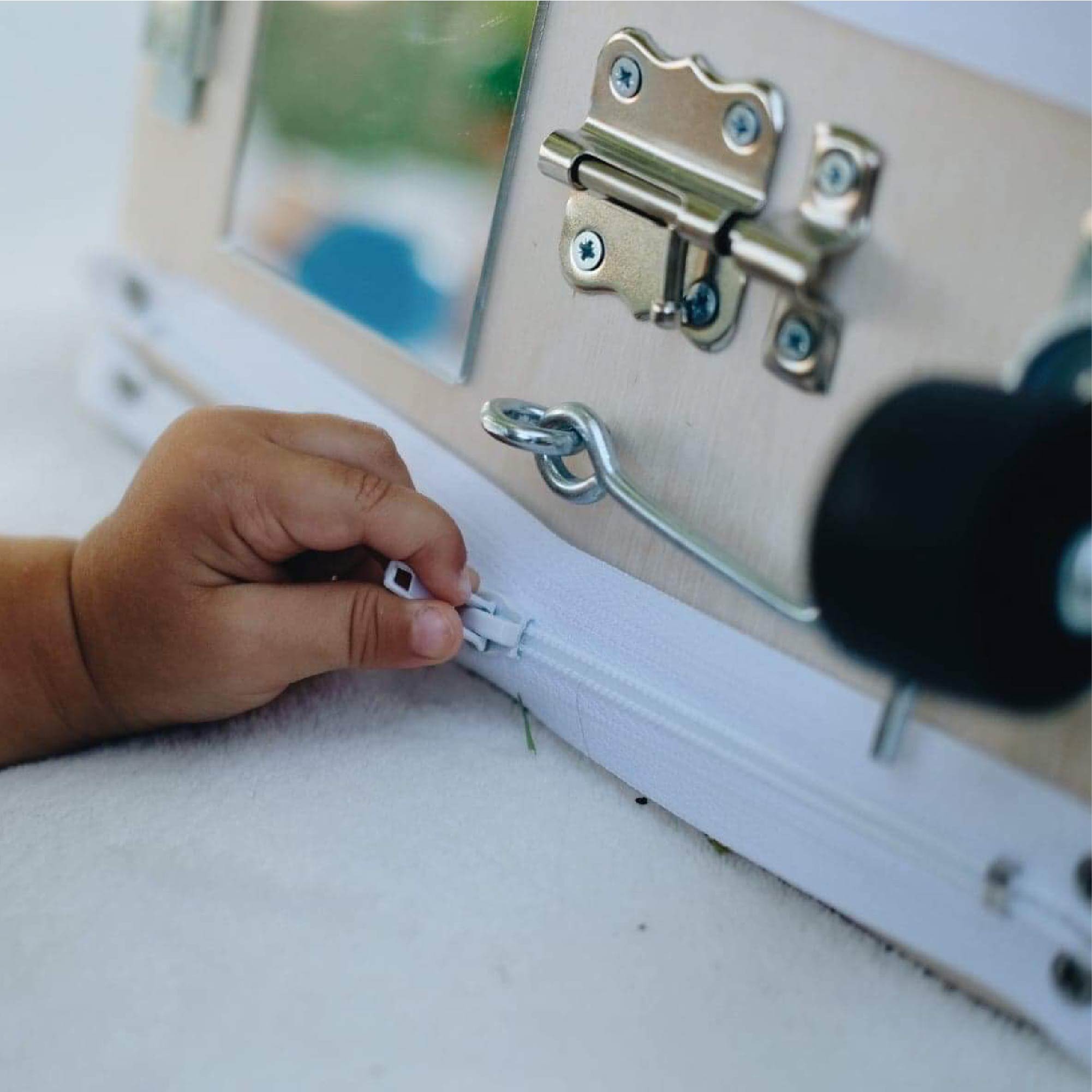
Now, speaking of logic… to ring the bell, you have to press the button. Or to open the door, you have to pull the latch up. What is happening here? The child builds a chain of inferences and learns cause-and-effect relations.
It goes without saying, that with such a diversified set of fun fidget toys, children enrich their vocabulary of random objects. Not only is the busy board a foundation for parents to introduce and explain new words. But it also serves as an emotional bonding instrument to connect with your child on a more intellectual level. So to say to share your adult wisdom. As a result, toddlers learn sentence structures and improve speech and diction.
And, certainly, not to forget about increased levels of perseverance, assiduity and concentration during play, as specialists note. Due to natural curiosity and desire to learn, the child strives to perform tasks diligently. They are not giving up. They go through trial and error, over and over again – until a positive result is achieved. And here you go – what a great exercise to promote problem-solving skills!
8. Woobiboo busy boards are great gifts for toddlers
Are you looking for a meaningful gift for a small child? Be it a baby shower, christening, a birthday party, or Christmas or Easter holidays – gifting a busy board is rewarding! It is highly appreciated by grown-ups. By the way, NeuroToys & Woobiboo even offer personalisation options for you, making a busy board unique.
Not only will toddlers play with delight, but also it will give parents a minute to breathe and relax with a cup of tea or coffee! Or for some even grab a salad! Moreover, sustainable minimalistic design of high-quality tactile boards fits perfectly any interior. Once outgrown, adults preserve it for another sibling, pass it from generation to generation, or simply sell in a Marketplace.
9. Our unique collection of Montessori busy board Switzerland from Woobiboo
We offer 6 types of tactile busy boards for toddlers, here in Switzerland:
- Our Woobiboard MINI is a great learning distraction for rather smaller children, until about 2 years of age. It could help in a restaurant, at a hotel and even in a car, train or boat.
- Some parents enjoy taking our portable busy board Activity Board Baby Premium DOUBLE on trips. Thanks to the busy board stand, it is easy to transport it in a car, for example, when going for a picnic or travel to another country. While grown-ups are socialising, children will be beneficially engaged with smart toys.
Besides that, our different busy board dimensions fit perfectly not only a Montessori kindergarten and a Montessori nursery but also traditional childcare centres (such as playgroups, and day-care facilities). You can mount it onto a wall or choose board options on a stand. Last but not least, Woobiboo activity boards are quite popular in waiting rooms and in play centres as well.
10. Conclusion
In essence, a high-quality Montessori busy board is a sophisticated puzzle with smart fidget toys to holistically and dynamically challenge and develop the brain of small children. The busy board comes to the rescue of mums, dads, uncles, aunties, grandparents and educational specialists. It’s a clever sensory board inspired by the Montessori approach. It promotes independent learning of the surrounding world. Children are in contact with fun random manipulation activities. As a result, they train their precision skills and develop intuition, logic, and sensory and tactile perceptions. They promote dexterity in their fingers, expand vocabulary and much more!
Enjoy Montessori from the start. Here you can buy Wooden Busy Board signature options. And remember: challenging the brain is never too late even for you! For instance, puzzling and 3D model building are intelligent and effective hobbies for grown-ups!








